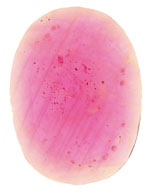Gemology
101 (The Jewellers Bench Gemology)
With the use of some very simple techniques and tools, it is possible for jeweller to identify some gemstone and diamond treatments.
Diamonds
Laser Drills:
Diamonds which have dark or black included crystal can be laser drilled in order to improve its overall appearance. In some cases, the apparent clarity grade may improve. With the use of a laser, it is possible burn away a dark or black included crysal leaving behind a white coloured residue. In most cases, this treatment is easy to identify by the long channel the laser drill leaves within the stone. See figure 1. to further identify that the channel seen is a laser drill, one should follow the laser drill to the surface and look for a tiny pin hole opening on the surface of the diamond.
 
Laser drilling is fairly easy to identify and is a very stable treatment. Laser drill treatment should and must be disclosed during the transaction of the diamond.
Fracture Filling:
The appearance of diamonds which have surface reaching fractures (feathers) can be improved by sealing the fractures with the use of a foreign substance. in some cases, the apparent clarity grade can improve. The foreign substance used is transparent with a similar refractive index as a diamond and is introduced into the fracture under pressure. Fracture filling is sometimes identified as Yeuda treatment.
The treatment is easy to identifiy by its distinctive violet/blue flash, which can be seen within any surface reaching fractures. The stability of the treatment can range from very unstable to stable under normal daily wear and tear. As well, some treaters provide a lifetime guarantee on the treatment. Full and complete disclosure should accompany all transaction, as well, a full understanding of the stability of the treatment.

Identifying Moissanite From Diamonds:
Mossanites made their first entry into the jewellery industry as a viable substitute to diamonds in the mid 90’s. Very high in clarity, Moissanite can be found in a wide range of sizes, shapes, and colours ranging from brown and yellow to the colourless range. Mossanite is considered a very good substitute to diamonds because it shares a similarity while dispersing light. The most obvious method of distinguishing the two is by using a mossanite tester. Another way to identify mossanite from diamonds is to look for the doubly refractive characteristic. When a light ray enters a mossanite it is split into two light rays and exits the stone as two rays. Whereas in a diamond, a light ray remains unchanged when it enters and exits a stone. This difference can be observed when the stones are examined with a 10X loupe. When looking for the culet through the bezel and star facets, the culet will be doubled in mossinites and remain only as one for diamonds.
Gemstones
Diffusion Treatments of Blue Sapphires:
Diffusion treatment improves the colour of a sapphire by applying a blue Blue colouring agent to the surface of the sapphire. This is accomplished by taking sapphires lighter in blue colour or heavily colour zoned and heating them along with the blue colouring agent. In most cases, this colouring agent is a mixture of alumina, titanium and iron. The result is that the agent will impart a blue colour onto the surface of the sapphire.

This treatment can be easily identified provided the sapphire is not set in a closed back setting. When the sapphire is viewed from the pavilion, the distinct concentration of the colouring agent along the facet edges can be seen. For blue sapphires which are unset, emmersing the stone table down into the small glass of water allows for a quick examination of the facet edges.
Diffusion treatments are fairly stable under normal wear and tear, but great care has to be taken to avoid any chipping of the sapphire. Since the treatment only affects the surface of the sapphire, any chips will chip away the applied colour.
Beryllium Treatments of Pink and Orange Sapphires:
Beryllium treatment first made it's way by the corrundom treaters in Chanthaburi, Thailand. The treatment initially was used to obtain the more desireable pinkish orange of colours found in Padparadscha Sapphire. The treatment introduces beryllium deep within the stone. As a result, a stone can be repolished without any identifying traces left on the facet junctions as in those of diffusion treatment. Though the treatment can be very difficult to detect, there are some tell tail signs the treatment leaves behind. These signs can be "red-flag" for further spectral analysis to be taken by a laboratory. Often, a secondary orangy pink hue is imparted within the outer layers of the stone with distinct colour concentrations. Secondly, the treatment entails extreme heat which can cause natural inclusions (ie. zircon) to melt and re-crytsalize into white forms resembling snowflakes.
 
Cluing in on the treatment with colour other than blue, can be as simple as imersing the stone in methalene iodide or even with alcohol and placing a bright light below it.
 
For an in depth look at diffusion and beryllium treatments, click here and read the artcle as published for Jewellery Business June 2008.
|